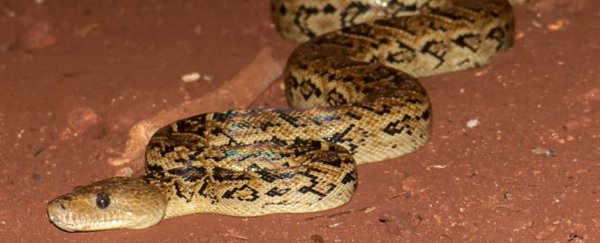If you ever had the misfortune of being hunted by a snake, in spite of everything, you could consider yourself lucky - at least it's not an entire nest of serpents teaming up to run you down and devour your flesh.
While scientists have never really been sure if snakes consciously coordinate their hunts - or just hunt as individuals competing for the same prey - new research suggests that coordinated snake pack-hunting is all too real.
Animal psychologist Vladimir Dinets from the University of Tennessee in Knoxville travelled to Desembarco del Granma National Park in Cuba, to observe how Cuban boas (Chilabothrus angulifer) hunt Jamaican fruit bats in sinkhole caves.
These boas have a distinctive way of hunting their prey - concealing themselves in small pit-like cavities that line the ceiling and walls near the cave's entrance.
There they lie and wait, hanging from the cave ceiling until the bats fly past on their daily commute, giving them an opportunity to strike. It would look a little something like this:
Sometimes, boas congregate at these hunting locations, and what Dinets wanted to know was whether they consciously coordinate their positions in the trap - spacing themselves to more effectively block the passageway and ensnare their prey in a hissing, snapping curtain.
Doing so would involve higher behavioural complexity in the animals than simply hunting alone, because it means they'd need to take into account each other's positions in addition to their own.
In eight days of observations that witnessed 16 different hunting events, Dinets found that whenever boas hunted at the same time in the cave, they chose positions in the same area, enabling them to be close to one another.
While this would leave other areas of the passageway clear, by teaming up next to one another, it was easier for the snakes to create a 'wall' that could snare any bats attempting to fly close to or between them.
That logic was borne out by the boa's hunting prospects. When more than one snake was present, the group hunts were always successful, whereas on the fewer occasions when only one boa turned up for the festivities, the loner sometimes left empty-handed.
According to Dinets, many of the world's 3,600 or so known snake species could coordinate their hunts in ways such as this - but scientists have yet to encounter the phenomenon, simply because we still know comparatively little about snake hunting tactics.
"It is possible that coordinated hunting is not uncommon among snakes, but it will take a lot of very patient field research to find out," he says.
Of course, many of us were captivated by something that looked very much like a snake pack hunt last year. Remember this piece of adrenaline-fuelled scrambling?
That award-winning segment of footage from the BBC's Planet Earth II sure looked like a bunch of snakes teaming up to take down that plucky (and extremely lucky) iguana, but as the team behind the documentary explained, this time, it's not a coordinated effort.
"They're not hunting in a pack," former research biologist and Planet Earth II producer Elizabeth White told Fast Company in February.
"I really stress that. There is no pack hunting element. There is no coordination. That area of the beach just has a vast number of snakes, and if one snake gets a whiff that there might be food and starts to make a move, all the others follow. They're like, 'Whoa, what's that? What's he seeing? I want it, too.'"
The Cuban boa, on the other hand, is laying out a more considered trap for its bat prey - but the sad part of the story is, it might not be pack-hunting much longer, thanks to declining numbers due to snake poachers.
"I suspect that if their numbers in a cave fall, they can't hunt in groups anymore and might die out even if some of them don't get caught by hunters," Dinets says.
"A few of these caves are in national parks, but there's a lot of poaching everywhere."
A salient reminder, in case it were needed, that snakes definitely aren't the bad guys here.
The findings are reported in Animal Behavior and Cognition.
